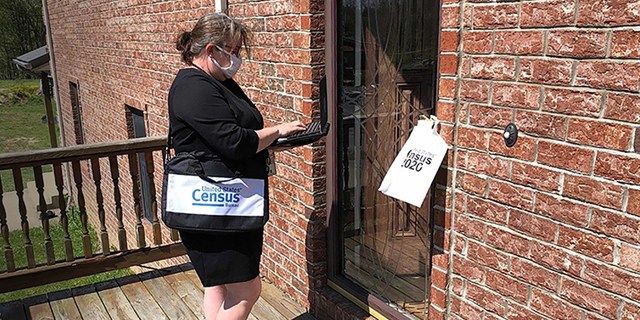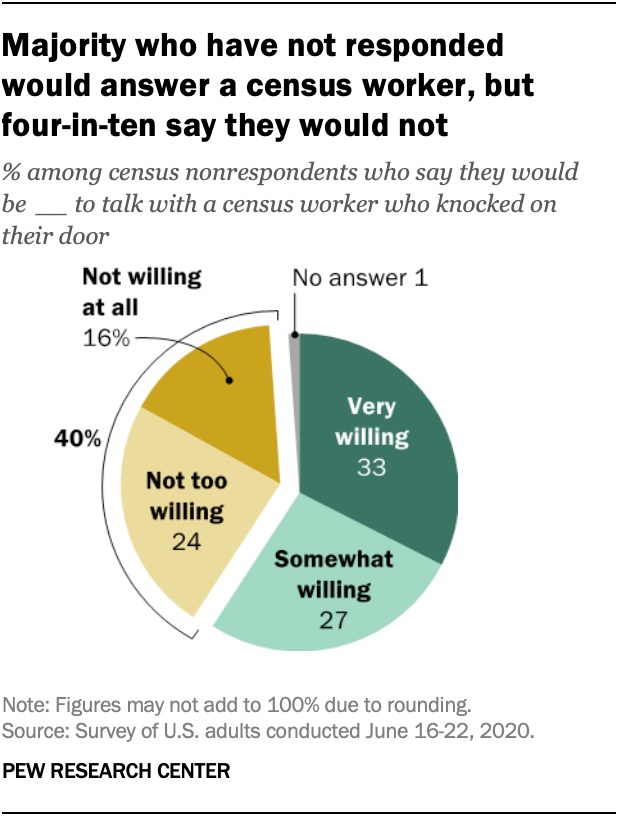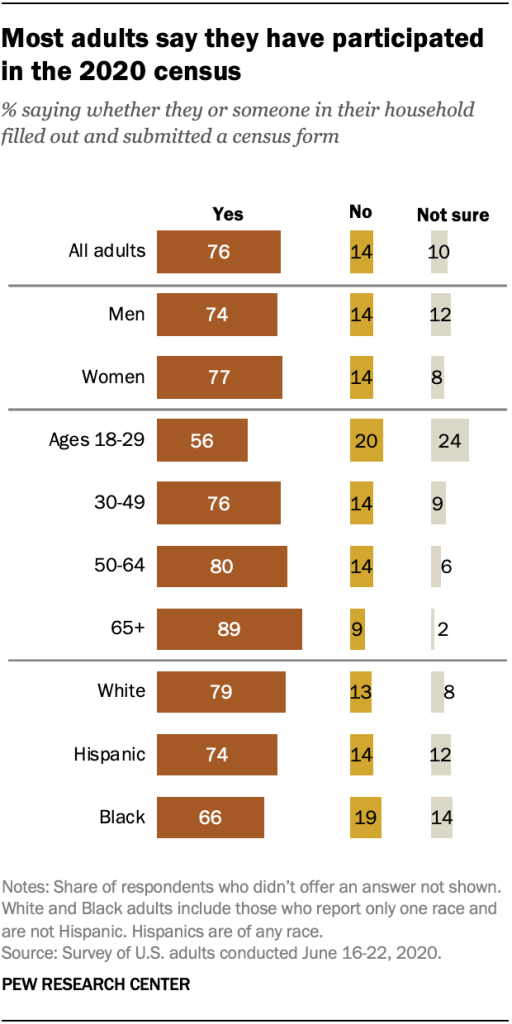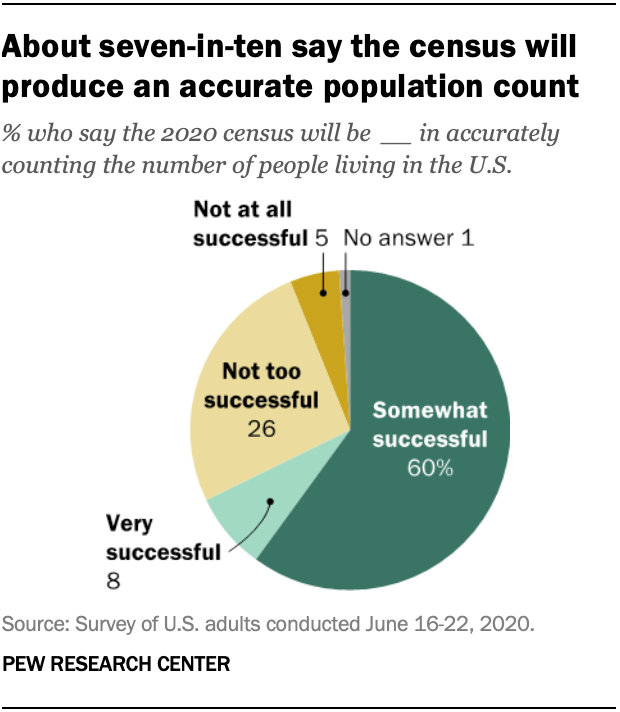
As 2020 census workers begin knocking on the doors of millions of U.S. households that have not returned their census questionnaires, four-in-ten U.S. adults who have not yet responded say they would not be willing to answer their door, according to a new Pew Research Center survey.
Among those who say they have not participated in the census, 40% say they would not be willing to talk to a census worker who came to the door; 59% say they would be at least somewhat willing. Those who have not responded to the census so far, according to the survey, are disproportionately likely to be from groups the census has struggled to count accurately in previous decennial census collections, including the Black and Hispanic populations.
The survey of 4,708 U.S. adults, conducted online June 16 to 22, finds that 76% say they or someone else in their household already responded to the census. Among the rest, 14% say their household has not responded and 10% are unsure. (The survey share who say they participated in the census is higher than the official Census Bureau response rate. See “How we did this” below for details.)
To examine attitudes about participation in the 2020 census, we surveyed 4,708 U.S. adults from June 16-22, 2020. Everyone who took part is a member of Pew Research Center’s American Trends Panel (ATP), an online survey panel that is recruited through national, random sampling of residential addresses. This way, nearly all U.S. adults have a chance at selection. The survey is weighted to be representative of the U.S. adult population by gender, race, ethnicity, partisan affiliation, education and other categories. Read more about the ATP’s methodology. Here are the questions used for this analysis, along with responses, and its methodology.
It should be noted the share who say they already responded in the Pew Research Center survey is higher than the official Census Bureau response rate. As of June 22, the final data collection date for our survey, 61.6% of U.S. households that were supposed to respond on their own had sent a response, according to data posted on the bureau website. (The Census Bureau expects nearly all households to respond on their own.) There are at least three possible reasons for the mismatch between our survey finding and 2020 census response rates. First, survey respondents may say they or someone in their household participated in the 2020 census, even though that is not the case. Respondents routinely overreport socially desirable actions such as voting or volunteering in surveys, although Pew Research Center surveys take steps to correct for the overrepresentation of civic and political engagement. Another possible reason is that some survey respondents may have mistakenly thought someone else in their household had returned the census form. Third, based on past decennial counts, the current official Census Bureau response rate likely is lower than the true response rate because the Census Bureau has not yet accounted for vacant or nonexistent addresses, which it will do later. For our census participation questions, we also made adjustments to account for the Census Bureau’s reported response rate.
Among adults in households that have not responded, 33% say they are very willing to talk with a census worker who knocks on the door, and 27% say they are somewhat willing. But 24% say they are not too willing, and another 16% say they are not willing at all.
Census Bureau follow-up visits to nonresponding households were originally scheduled to begin in early May, but they were delayed by a freeze on census field operations due to the COVID-19 pandemic. Workers began knocking on doors of these households earlier this month in six regional areas, and the bureau plans to expand its follow-up operation to communities nationwide in August. Those making the visits are required to wear masks and to stand outside when conducting interviews, according to the agency. The bureau also plans to conduct in-person interviews from late September through late December as part of other operations to improve or measure data quality.
The bureau’s nonresponse follow-up plan requires census workers to make at least one attempt to reach each household that has not responded. If no one answers the door, and the bureau determines the home is occupied, census workers may try to get information about people living there from proxy respondents, such as neighbors, or from other government records. As a last resort, the Census Bureau will use a statistical technique, called imputation, to count the occupants and list their characteristics.
Who says they have participated in the census?
White adults (79%) are more likely to say they have responded to the 2020 census than adults who are Hispanic (74%) or Black (66%). In part, this reflects current response patterns: Based on local-level response rates published by the Census Bureau, heavily Black or Hispanic neighborhoods have lower participation rates so far than heavily white neighborhoods, according to the Center for Urban Research at the City University of New York. U.S. Black and Hispanic populations have been undercounted in past censuses, according to the Census Bureau’s own research, while the white population has been overcounted.
Adults ages 18 to 29 also are less likely to say they have participated than adults in each older age group. A little over half of young adults (56%) say they or someone else in their household returned the census form, compared with 76% of adults ages 30 to 49 and even higher shares in age groups older than that.
Pew Research Center surveys earlier this year – before census mailings were received in most households – found that Black and Hispanic adults were less likely than white adults to say they planned to participate in the 2020 census. The same was true of young adults compared with older ones.
The new survey also finds clear educational attainment and income differences: Those who have at least a college degree and those with higher incomes are more likely to say they have participated. Midwesterners are more likely than residents of other U.S. regions to say they have participated, echoing Census Bureau numbers showing that Midwestern states mainly have response rates at or above the national average. Republicans (78%) are slightly more likely than Democrats (75%), including those who lean toward each party, to say they have responded – which at least in part reflects the racial makeup of each party’s followers.
Among those who say they have not participated, 70% say they or someone else in their household definitely or probably will respond to the census, and 26% say they definitely or probably will not.
Most expect the 2020 census will be at least somewhat successful
The decennial census, a count of everyone living in the United States as of April 1, is used to apportion the number of seats each state has in the U.S. House of Representatives and guide the distribution of at least $1.5 trillion a year in federal funds. The coronavirus pandemic has disrupted the count, forcing the Census Bureau to extend data collection by three months, to Oct. 31.
About seven-in-ten adults say they think the 2020 census will be very successful (8%) or somewhat successful (60%) in accurately counting the number of people living in the U.S., according to the Center’s new survey. An additional 31% say the census will be not too successful (26%) or not at all successful (5%) in doing so. In an earlier Pew Research Center survey, conducted in late February and early March, 75% said the census would be somewhat or very successful, and 24% said it would not be.
In the latest survey, women (34%) are more pessimistic than men (27%) about the census not succeeding. Republicans and GOP leaners (33%) are more likely to fall into the pessimistic camp than Democrats and Democratic leaners (29%).
Note: Here are the questions used for this analysis, along with responses, and its methodology.



